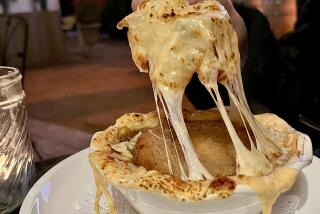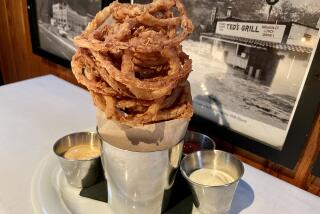Thanksgiving : All About Onions
- Share via
One of the best things about Thanksgiving is creamed onions--not just the pungent, richly sauced vegetables themselves, but the reminder that onions are a vegetable, worthy of being enjoyed in their own right.
There’s nothing obscure about onions; no seasoning is more ubiquitous. But when it comes to enjoying them for themselves alone, after onion rings all is silence. It shouldn’t be that way; onions are not only delicious, they’re easy to prepare (especially if you use big ones instead of those little white ones), low in calories (about 40 for a medium onion) and, like garlic, they may turn out to have cholesterol-lowering properties (stay tuned).
Knowing Your Onions
The big difference is between sweet, Spanish-type onions and the more pungent varieties such as the standard yellow globe, which accounts for about 75% of the onions in U.S. markets.
Sweet onions--including red torpedo and hamburger onions, Vidalias, Walla Wallas as well as standard Spanish--are milder, softer and juicier than what might be called “regular” onions. They also spoil more quickly; standard onions are called “storage type” in seed catalogues and in the trade.
Either kind can be used in most recipes, but results won’t be the same. The sweetest onions can fade to blandness when cooked; the pungent ones can be disagreeable in salads. Sweet onions also shed more liquid and cook down softer than their stronger-flavored, firmer-textured cousins.
Buy sweet onions only as needed, storage types any time. Store all onions in a cool, dark, fairly dry place--not the refrigerator--and keep them away from potatoes. Because of the gasses each gives off, potatoes and onions will both spoil more quickly if stored together.
Onions can be used in salad, stir-fried or grilled, but those cooked for a long time are the gentlest:
There is in every cook’s opinion,
No savory dish without an onion:
But lest your kissing should be spoiled
The onion must be thoroughly boiled.
--Dean Swift
Baked Onions
These are as simple to make as baked potatoes and almost as versatile. Butter, salt and pepper are the classic accompaniments, but they’re moist and rich-flavored enough to do fine without the butter. Like baked potatoes, they taste great dressed with sour cream and chives, curried yogurt, or, once cold, with vinaigrette. Italian and Mexican tomato sauces go well with them, and when you’re bored with those, there’s melted cheese, sauteed mushrooms, or a sweet and sour glaze made from a dab of butter, a slug of maple syrup and a squeeze of lemon.
Baked onions take a long time to cook, from one to two hours depending on size and oven temperature, so plan to cook them while something else is in the oven. And do make extras while you’re at it. Leftovers will keep for three or four days, and they reheat very well.
Plan on one large or two medium onions per serving. The type doesn’t matter--sweet onions cook faster, but firmness is important; onions for baking should be as hard as possible. Trim off any dirt-bearing root and peel the loose outer skin but leave the tight inner skin. Rinse and dry, cut a thin slice from the neck so steam can escape, then put them in a shallow pan just large enough to hold them comfortably. Bake at anywhere from 325 to 425 degrees for one to two hours, until they give slightly when pressed.
To serve onions in skins, cut a slit in one side and push meat up, just as you would a baked potato. The skins themselves aren’t eaten, so for fancier service, remove them in the kitchen. There will be a small amount of caramelized onion juice in the pan. Pour in a few tablespoons of warm water, cider, wine, vinegar, or cream, stir over low heat until sauce forms and serve it with the onions.
Variation:
Easy, Comparatively Low-Calorie Creamed Onions
For each serving:
1 large or 2 medium onions
Salt
White pepper
Ground nutmeg
1 tablespoon whipping cream, preferably not ultra-pasteurized
Make Baked Onions as above but peel each onion and cut in half horizontally. Loosen cooking juices with warm water and use sauce to paint bottom and sides of baking pan just large enough to hold onion halves when crowded together. Single servings do well in onion soup crocks; an 8-inch-square brownie pan will hold enough for six.
Arrange onions in pan, cut sides up. Sprinkle with salt, white pepper and nutmeg and pour whipping cream over. Cover loosely with foil. Bake at 350 to 375 degrees about 30 minutes or until heated through. Serve at once.
These are somewhere between a vegetable and a sauce, very rich tasting but not at all heavy, slightly sweet and sour. Wolfert suggests serving them on toast, with drinks, or with squab, calves liver or duck. I like them with grilled tuna, on baked squash, and with sweet potatoes.
RED WINE-COOKED ONIONS (From “The Cooking of Southwest France,” by Paula Wolfert)
1/4 cup unsalted butter
2 1/2 to 3 pounds Spanish onions, halved lengthwise and thinly sliced
1 tablespoon sugar
1 1/2 cups full-bodied red wine (Petite Sirah or Cotes-du-Rhone)
Salt
Freshly ground pepper
1 teaspoon red wine vinegar, about
Heat butter in 4-quart saucepan (not aluminum) over low heat. Add onions. Cover and cook 45 minutes, stirring occasionally.
Uncover and increase heat to medium-high. Cook, stirring frequently, until onions are glazed and golden brown, about 20 minutes or longer (avoid scorching). Sprinkle with sugar and boil down, stirring, 2 to 3 minutes to glaze.
Reduce heat to low, add wine and cook, stirring frequently, until onions are very tender and deep mahogany in color, about 1 1/2 to 2 hours.
Season to taste with salt and pepper, adding vinegar to counteract sweetness. Serve hot, lukewarm or cold. Makes about 2 cups or 6 servings.
Note: Onions will keep in refrigerator 2 to 3 days, or freeze for longer storage.


